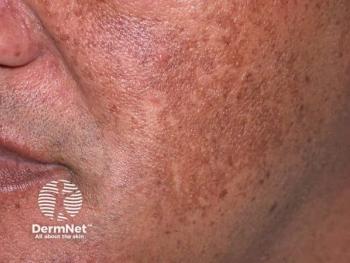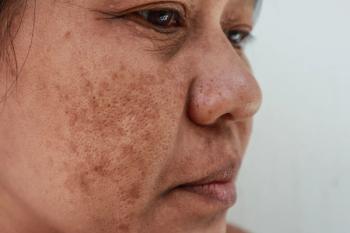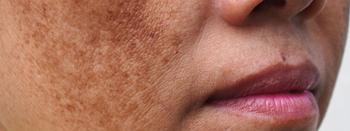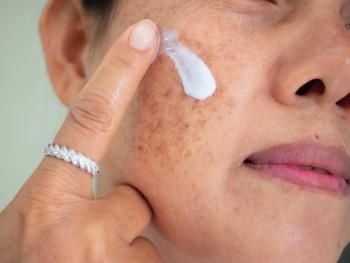
Treating acquired hyperpigmentation: It’s complicated
It’s becoming clear that treating hyperpigmentation is much more than targeting the tyrosinase enzyme with topical hydroquinone.
Hyperpigmentation has many causes, triggers and potentials for treatment, according to Arianne Shadi Kourosh, M.D., M.P.H., director of Community Health and the Pigmentary Disorder and Multiethnic Skin Clinic at Massachusetts General Hospital. Dr. Kourosh, who also directs Laser and Cosmetics at Brown University Medical Center, presented “Fifty Shades of Brown-Science, symptoms and strategies for acquired pigmentary disorders” at this year’s American Academy of Dermatology (AAD) annual meeting.
What’s New?
Recent scientific breakthroughs are changing how scientists and providers think about normal melanocyte biology and abnormal pigment physiology, according to Dr. Kourosh.
“When it comes to hyperpigmentation, classically we used to think only about the melanocytes and whether they were producing melanin pigment at a faster rate,” she says. “More recently, we started to think about other steps in that pathway of hyperpigmentation, including the transport of melanin from melanocytes, to keratinocytes, to other skin cells.”
Newer studies suggest the protease activated receptor 2 (PAR2) enzyme is involved in transporting melanin into keratinocytes. In the past, most treatments, including hydroquinone and other topicals, targeted and blocked the tyrosinase enzyme.
“Now there is increase emphasis on not just blocking pigment production but also blocking pigment transport through this other enzyme,” Dr. Kourosh says.
Diagnosis Considerations
Simply making the diagnosis of dyschromia in patients with a broad range of skin colors can be challenging for even dermatologists.
“I think that the most important thing is getting experience in seeing the same problem in lots of different skin types, because dyschromia may be more subtle and harder to pick up on in patients with darker skin types,” Dr. Kourosh says.
Dermatologists should be able to distinguish different pigmentation types, including whether the pigmentation is in the epidermis or if there’s deeper involvement. Different colors also can occur in hyperpigmentation, depending on the cause or causes. For example, some medications increase patients’ sensitivity to the sun.
“If the hyperpigmentation is due to a medication exposure, it could have other hues in it, like gray or bluish pigmentation. The areas involved might not just the face. It could be on other areas that are exposed to the sun like the arms or upper chest,” she says.
Newer Treatment Options
Dr. Kourosh says that most pigmentary experts agree that the gold-standard treatment for hyperpigmentation remains triple therapy with a hydroquinone, a retinoid and a steroid, in conjunction with sun protection.
“But I think that now other therapies are being considered in combination with this, such as cosmeceutical agents that block pigment transport,” she says. “Soy extract that’s in certain cosmeceuticals is actually a blocker of the PAR2 enzyme.”
Some providers combine topical therapies, superficial chemical peels or lasers treatments. But Dr. Kourosh says using peels or devices on skin of color is tricky and requires skill and experience.
“Different skin types react differently to chemical peels and lasers and hyperpigmentation can easily be exacerbated. So, it’s a very delicate balance of understanding how to use a combination approach to help patients reach their goals,” she says.
One of the big advances in managing and preventing acquired hyperpigmentation is a better understanding of optimal sun protection and skin protection from environmental triggers that could increase skin pigment.
Many chemical sunscreens, for example, protect the skin primarily against ultraviolet B (UVB) and not so much against UVA, which, according to Dr. Kourosh, has an important role in causing hyperpigmentation.
“In recent years there has been research highlighting the role of longer wavelengths in causing hyperpigmentation,” she says.
The culprits? UVA radiation, as well as visible light.
“Visible light can cause hyperpigmentation especially in darker skin types with a more severe and lasting effect in some cases. And infrared radiation - heat radiation - can worsen hyperpigmentation,” she says.
Dr. Kourosh experienced the effect of infrared radiation in a recent hyperpigmentation patient who worked near an oven. She was frustrated that while she complied with topical therapy, her hyperpigmentation got worse. Dr. Kourosh asked about the patient’s job and realized her work might be causing the increased pigment in her skin. Dr. Kourosh wrote a letter to the patient’s employer asking that the patient be stationed away from the oven and her hyperpigmentation slowly improved.
Yet another potential cause is exposure to pollution, according to Dr. Kourosh.
“There have been large studies that have shown that people who live in more polluted areas experience hyperpigmentation and superficial wrinkling at an earlier age than their counterparts,” she says. “There are various kinds of pollutants that can become airborne and actually come in contact with the skin, causing damage, including hyperpigmentation. It can cause corrosion of the protective lipid barrier of the skin.”
A Multilayered Treatment Regimen
The aim of hyperpigmentation treatment should be to not only topically address the excess pigmentation but also protect patients’ skin from potential exposures that might worsen the condition.
“We can treat people. But if they’re continuously exposed to these triggers, how much progress can we hope for?” she says.
Dr. Kourosh says she recommends barrier, instead of chemical, sunscreens. Zinc, titanium and iron oxide form a barrier and are more likely to protect the skin against not only UVB and UVA sun exposure, but also visible light and other triggers. Patients should apply the sunscreen in the morning, or if they use makeup could use a layer of makeup that contains sunscreen.
“New products are basically mineral sunscreens with a little pigment in them. Patients love that because the sunscreen is more cosmetically acceptable and less obvious,” she says.
To clean the skin of daily pollutants, Dr. Kourosh recommends a good cleansing regimen. After cleansing, she recommends patients use a moisturizing regimen to restore the protective lipid barrier.
Newsletter
Like what you’re reading? Subscribe to Dermatology Times for weekly updates on therapies, innovations, and real-world practice tips.


















